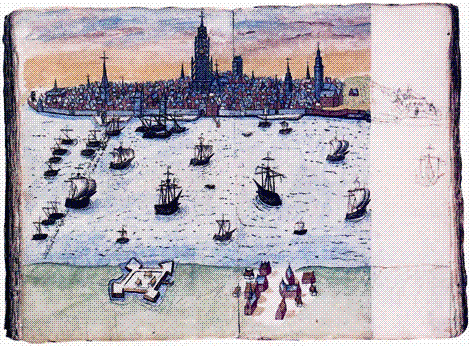
Antwerp 1602 (note the mini Star Fort Source
The Netherlands, Holland or the Low Countries, have played a significant role throughout this series. As far as the Jewish presence there goes, we get the same story whereby they probably arrived with the Romans, although they probably didn’t. Documentary evidence is only available from the 1100's, which shows they arrived on the northern European scene coincidentally with the Norman's rise to power, as mentioned in Part 1. They were blamed for The Black Death that occurred between 1347 and 1351 just as they were in England. There were also identical accusations of blood libel and host desecration as in England. Which is odd, when you consider that there was no internet, TV, telephones, radio or even a postal service. International communication took weeks if not months and was totally out of the question for the type of uncouth ignorant peasant we are supposed to believe did all the persecuting. Many of the Jews expelled from England went to the Low Countries.
● Introduction ● The Jewish presence in the Low Countries
● Calvinism/Cohenism ● The House of Orange
● William of Orange’s Grooming
● Oliver Cromwell’s sneeky Act of Seclusion
● The international & intersecular conspiracy to make William of Orange king of the Netherlands
● The vicious propaganda campaign against King James II
● The Declaration of Indulgence or Declaration for Liberty of Conscience

Antwerp 1602 (note the mini Star Fort Source
“From the 15th century, Jews also resided in the Northern Netherlands. Their most important occupation was moneylending, making them dependent on the economies of the cities. [F:...shouldn’t that be the other way around?] In this way, Nijmegen became an important financial marketplace where a great many of Jewish families came to settle. Nonetheless, Jews continued to choose the large cities in the Southern Netherlands as for their home base.
“In the 16th century the city of Antwerp came to be a very important location for Jewish tradesmen and moneylenders because of its flourishing economy. This also turned it into a refuge for a number of Marranos who had been expelled from Spain and Portugal by the Inquisition after 1492. Jewish bankers usually settled there using a Christian pseudonym. Francisco Mendes, born into a distinguished family of bankers, opened a branch in Antwerp that was one of the largest banks in Europe... The flourishing Jewish trade in Antwerp ended, however, when The Netherlands were divided during the reign of king Philip II [of Spain] and, by the end of the century, many Jews took refuge in the Northern Netherlands, especially in Amsterdam where they formed a community.” Source
F: It’s interesting that the Jews are always described as ‘taking refuge’ rather than settling or invading somewhere.
“Amsterdam, however, did not recognize religions other than Protestantism. The community was discovered, and its leaders arrested, in 1603. As a result, some of the newly-acknowledged Jews moved to the towns of Alkmaar, Rotterdam, and Haarlem, which extended them protective charters. The majority, however, remained in Amsterdam, and even founded a second community there in 1608.” Source
That all sounds very odd…
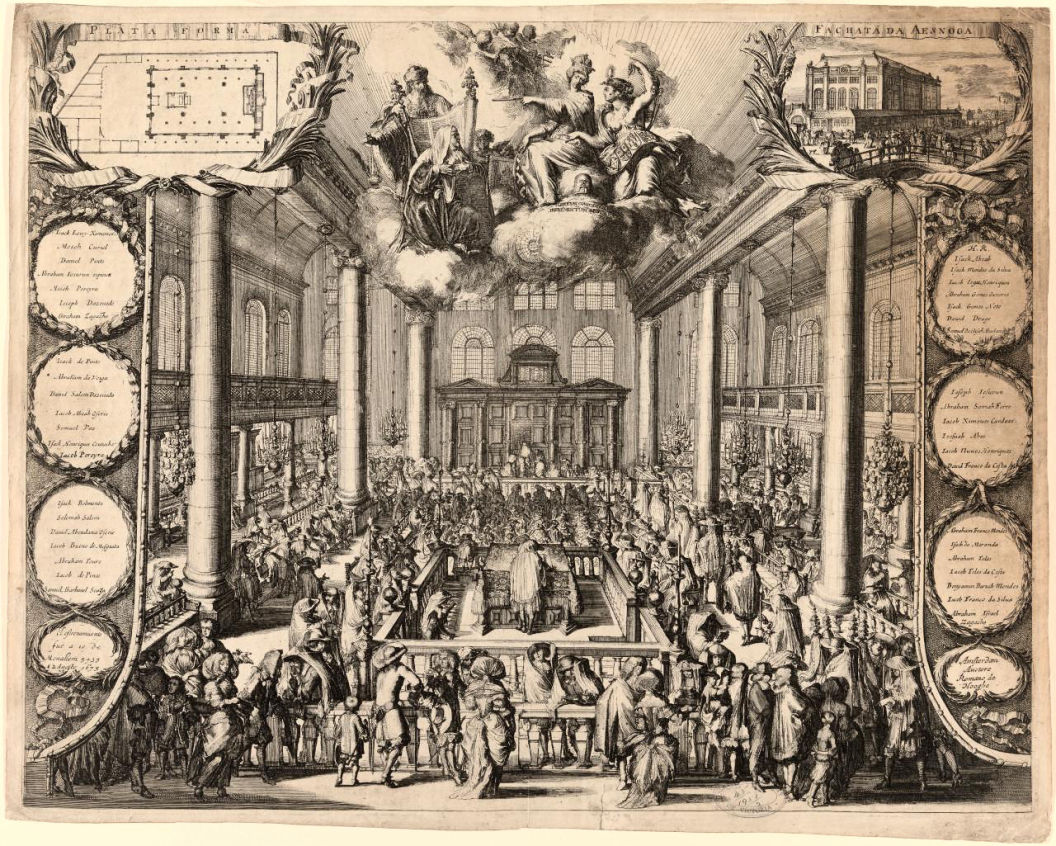
The Portuguese Synagogue in Amsterdam Source
In fact the particular flavour of Protestantism in Amsterdam and all of the Netherlands was Calvinisim:
Source: “Pawns in the Game”, William Guy Carr:
“Contrary to general belief, Calvinism is of Jewish origin. It was deliberately conceived to split the adherents of the Christian religions, and divide the people. Calvin’s real name was Cohen! When he went from Geneva to France to start preaching his doctrine he became known as Cau[v]in. Then in England it became Calvin. History proves that there is hardly a revolutionary plot that wasn’t hatched in Switzerland; there is hardly a Jewish revolutionary leader who hasn’t changed his name. At the B’nai B’rith celebrations held in Paris, France, in 1936 Cohen, Cauvin, or Calvin, whatever his name may have been, was enthusiastically acclaimed to have been of Jewish descent. (This fact was commented upon in the Catholic Gazette in February of that year.)”
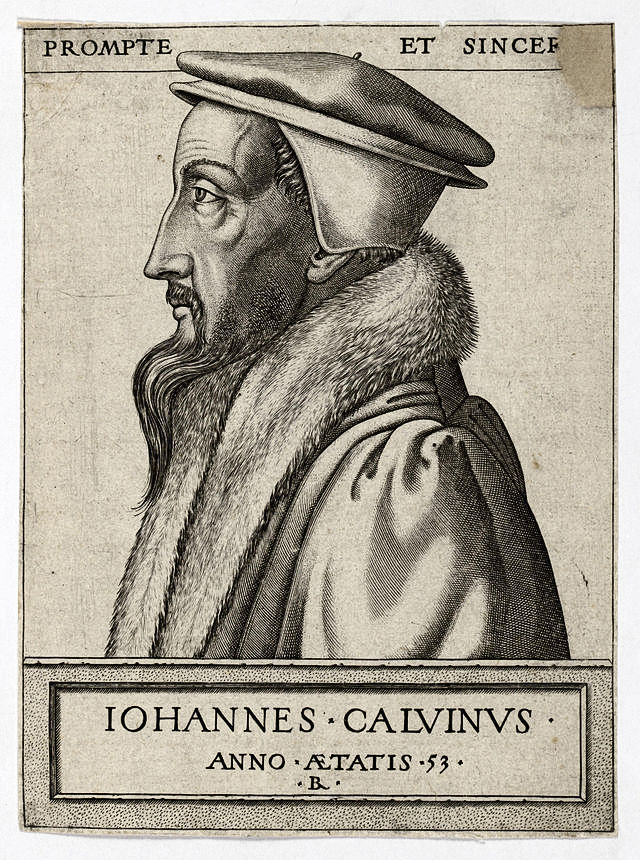
John Cohen-Cauvin-Calvin Source
In 1648 the Dutch principalities, led by William I of Orange, rebelled against Spanish rule and formed the United Provinces of the Netherlands. This is when the Low Countries split in two. The Netherlands in the north separated from the southern provinces (present-day Belgium and Luxembourg), which continued under Habsburg Spanish rule until 1714.
Previously the Habsburgs had appointed a ‘Stadtholder’ or kind of Sheriff or Lord Lieutenant, to govern the Low Countries in their stead. Through William I’s victory over the Spanish, the role of Stadtholder became hereditary to the House of Orange – especially the one’s called Bill. After the split from Spain the role continued as that of the head of state… on and off. William I of Orange was assassinated in 1580, because even after the split from Spain and thus freedom from its religious persecution of the Protestant Calvinists, there just had to be some kind of issue to divide the people and serve the hidden agenda – republicanism.
William II Prince of Orange married Mary Stuart, daughter of Charles I, King of England, in 1642. Their son was born in 1650 (1+5=6, 66) one week after his father died. Let’s call this one Bill the Orange. There was a great deal of controversy over Bill the Orange’s upbringing. In spite of his mother and his uncles being Catholics, Bill was indoctrinated into Calvinism.
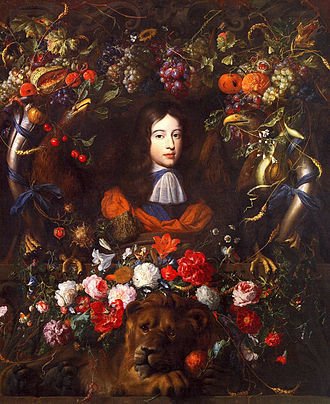
William Prince of Orange...
with some oranges Source
The young Bill's education became a tussle between English royalty and the States of Holland until: “In 1666, when William was 16, “the States officially made him a ward of the government, or a "Child of State". All pro-English courtiers, including Zuylenstein [FN: Bill’s half-brother], were removed from William's company. William begged De Witt to allow Zuylenstein to stay, but he refused. De Witt, the leading politician of the Republic, took William's education into his own hands, instructing him weekly in state matters and joining him for regular games of real tennis.” Source
Bill the Orange was being groomed by a republican, Johan de Witt, who opposed the House of Orange-Nassau and the Orangists. He was also strongly liberal, preferring lesser power to the central government and more power to the Regenten (Regents) and he had big plans for Bill. Since the 1500s Dutch cities had been run by these Regenten - rich merchant families, who had gradually formed a closed elite and created an oligarchy that ruled the Dutch Republic and whose members were the leaders of the Dutch cities.
“After the death of William's father, most provinces had left the office of stadtholder vacant. By demand of Oliver Cromwell, the Treaty of Westminster [1654], which ended the First Anglo-Dutch War, had a secret annexe that required the Act of Seclusion, which forbade the province of Holland from appointing a member of the House of Orange as stadtholder.” Source
By means of this Act of Seclusion, The ‘Jewish Messiah’, Cromwell, prevented the Regentsen from appointing Bill the Orange as their Stadtholder puppet because he was already spoken for in the puppet department.
“While in general, European Jews isolated themselves economically and socially as well as politically, the Jews of the Netherlands enjoyed, as early as the seventeenth century, economic and social integration that the rest of European Jewry would not know for hundreds of years. Professions like medicine became very popular, and Jewish physicians were free to practice even among non-Jews. More importantly, the Jews, particularly the Sephardim, played a large role in the economic expansion that elevated the Netherlands to a world center in the 1600s. The Portugese Jews, with their knowledge of languages and connections to the international trade network of Jews and Marranos, became important in the shipping and trading industries. Several Jews were important shareholders in the Dutch East Indies Company, which dominated international trade during the seventeenth and eighteenth centuries. Jews became prominent in other businesses as well, succeeding in the tobacco, sugar refining, and printing industries. Most of all, the diamond industry soon became an almost exclusively Jewish occupation due to their success in it.” Source
In 1672 the Dutch Republic was simultaneously attacked by:
Following this onslaught, Bill the Orange was “swept to power” to become King of The Netherlands. The ‘Orangists’ took over the Dutch government. Johan de Witt and his brother got the blame for the defeat and were lynched.
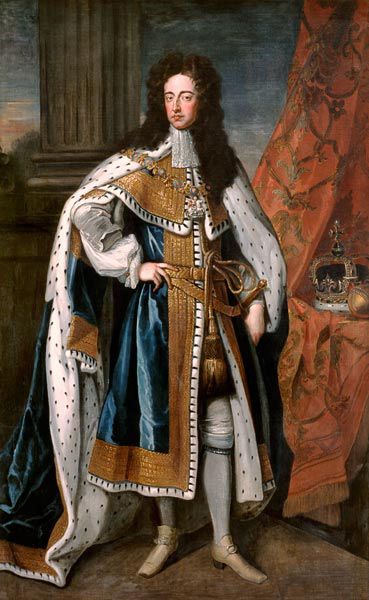
Bill the Orange Source
Here we have a coalition between Catholics and Protestants which achieved nothing more than placing Bill the Orange on the throne of the Netherlands and delivering a slap to the wealthy Regentsen of Holland. Exactly what was the common interest?
Eventually, by 1674, England and Holland were at peace. Well, Bill the Orange was on a roll, because no sooner had he met Princess Mary of England, the eldest daughter of the English Duke of York, than they married in 1677 and he found himself right near the top of the queue for the throne of England, Scotland and Ireland. All that stood in his way was his uncle, The Duke of York (James II) and King Charles II himself.
After a failed assassination attempt in 1683 and King Charles II’s death in 1685, The Duke of York became King James II of England, VII of Scotland and Ireland. Immediately a campaign of L’Infamie was started against him. In that same year there was an insurrection which also failed and resulted in over three hundred people being sentenced to death in circumstances of atrocious cruelty. Nearly one thousand others were condemned to be sold as slaves. England was in a state of perplexity.
“The Declaration of Indulgence or Declaration for Liberty of Conscience was a pair of proclamations made by James II of England and VII of Scotland in 1687. The Indulgence was first issued for Scotland on 12 February and then for England on 4 April 1687. It was a first step at establishing freedom of religion in the British Isles.
“The Declaration granted broad religious freedom in England by suspending penal laws enforcing conformity to the Church of England and allowing persons to worship in their homes or chapels as they saw fit, and it ended the requirement of affirming religious oaths before gaining employment in government office.
“By use of the royal suspending power, the king lifted the religious penal laws and granted toleration to the various Christian denominations, Catholic and Protestant, within his kingdoms... Some Anglicans objected to the fact that the Declaration had no specified limits and thus, at least in theory, licensed the practice of any religion, including Islam, Judaism, or paganism.” Source
“The English Roman Catholics provided a foundation far too narrow for the throne to rest upon with safety, James and his Jesuit advisers — for it must be remembered that he, like Louis, had allied himself not with the Pope but with the Jesuits — resolved to seek the alliance of the Protestant dissenters.” Source
No more religious schisms or persecution!?* Stay tuned…
The Betrayal of Albion Part 1: The City of London
The Betrayal of Albion Part 2: 1066 and all that Bollocks
The Betrayal of Albion Part 3: The English Revolution
The Betrayal of Albion Part 4: The Great Fire of London
The Betrayal of Albion Part 5: The Dutch Puppetmasters
The Betrayal of Albion Part 6: The Glorious Revolution
The Betrayal of Albion Part 7: Conclusion & Modus Operandi
Felix Noille
.
IF YOU ARE SEEING A LINK TO MOBIRISE, OR SOME NONSENSE ABOUT A FREE AI WEBSITE BUILDER, THEN IT IS A FRAUDULENT INSERTION BY THE PROVIDERS OF THE SUPPOSEDLY 'FREE' WEBSITE SOFTWARE USED TO CREATE THIS SITE. THEY ARE USING MY WEBHOSTING PLATFORM FOR THEIR OWN ADVERTISING PURPOSES WITHOUT MY CONSENT. TO REMOVE THESE LINKS I WOULD HAVE TO PAY A YEARLY FEE TO MOBIRISE ON TOP OF MY NORMAL WEBHOSTING EXPENSES - WHICH IS TANTAMOUNT TO BLACKMAIL. I CALCULATE THAT THEY CURRENTLY OWE ME THREE MILLION DOLLARS IN ADVERTISING REVENUE AND WEBSITE RENTAL.